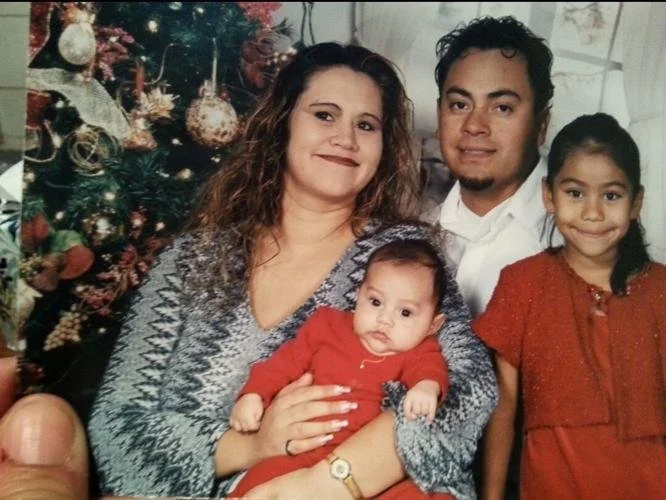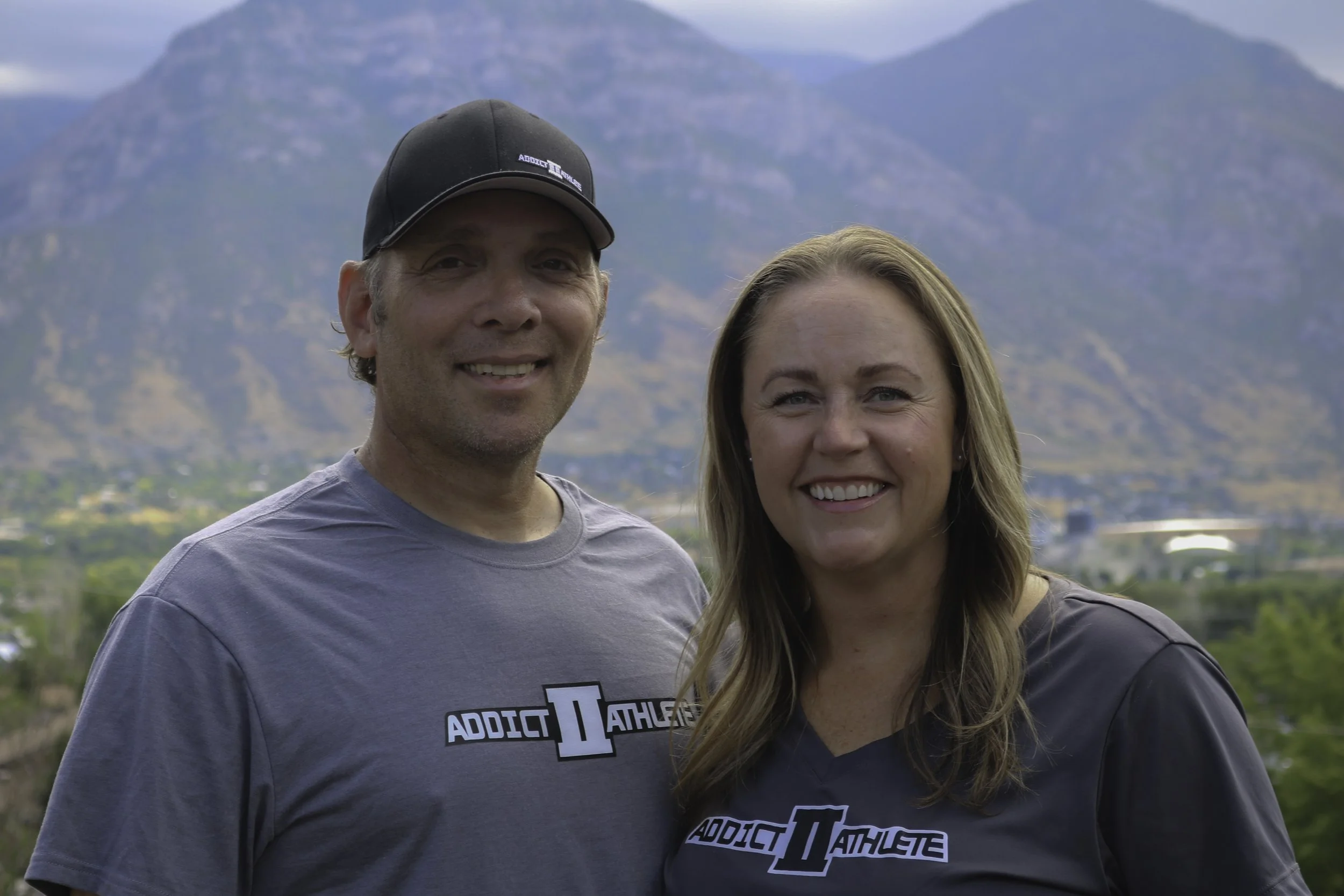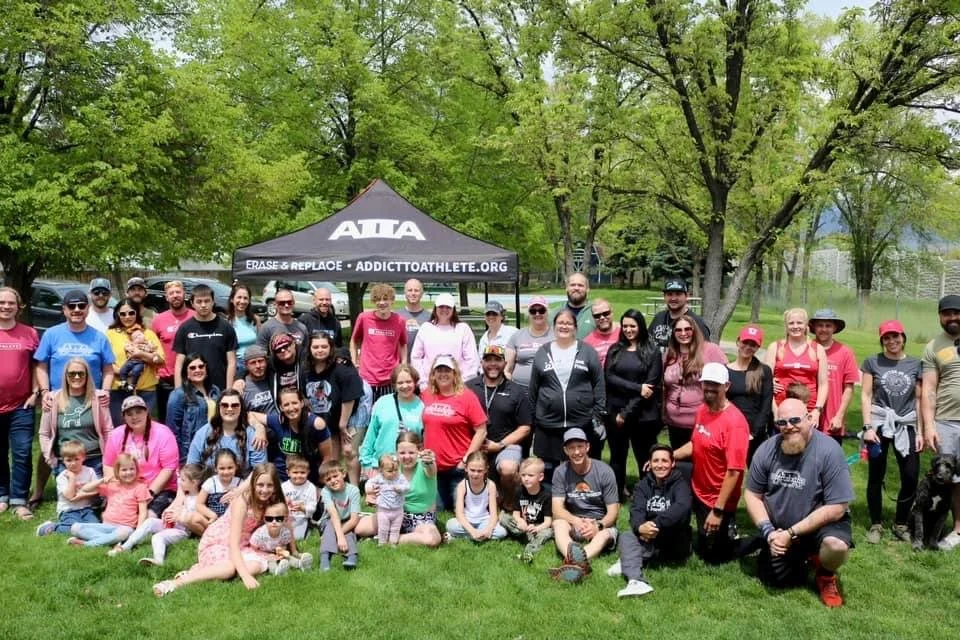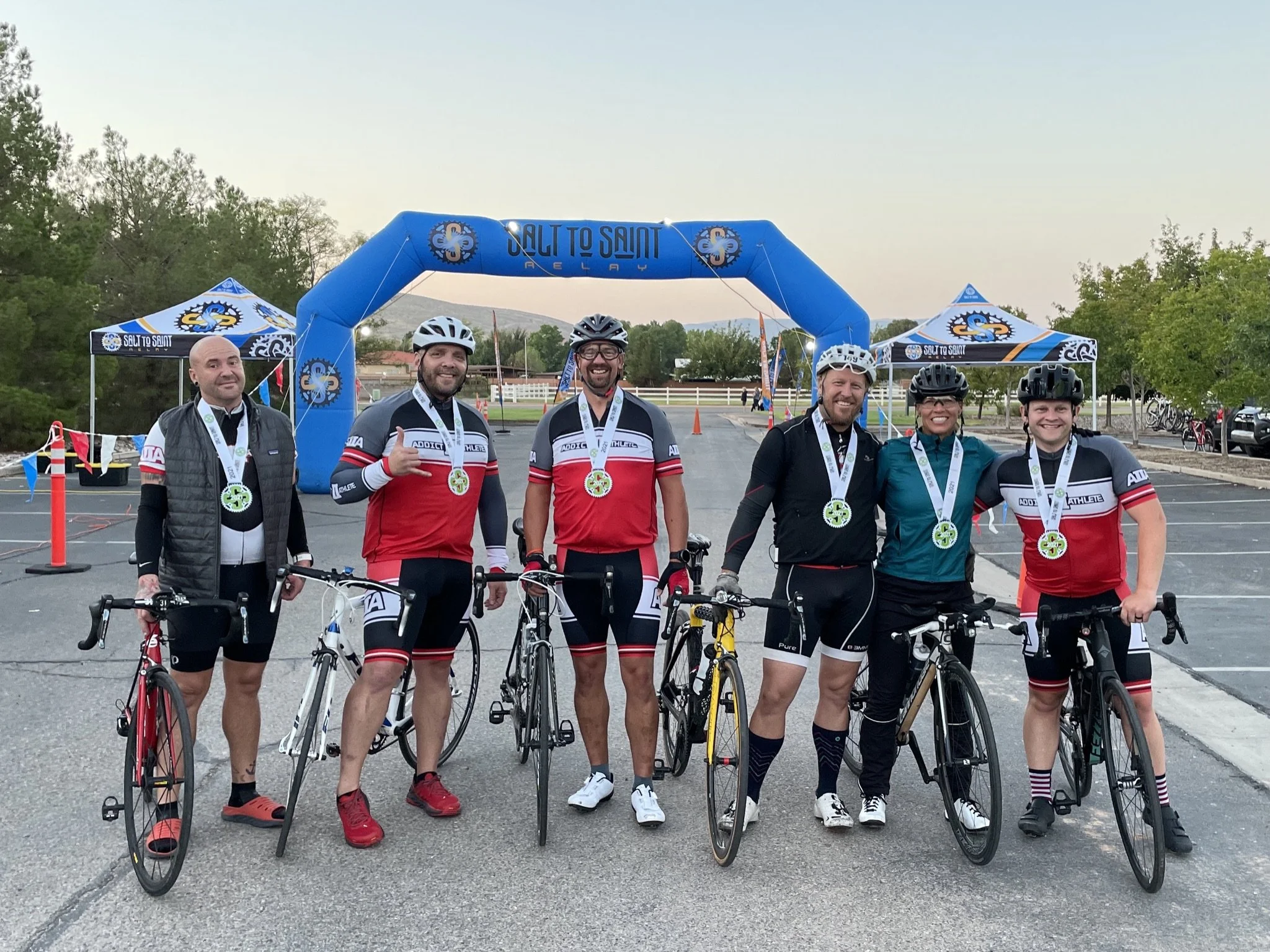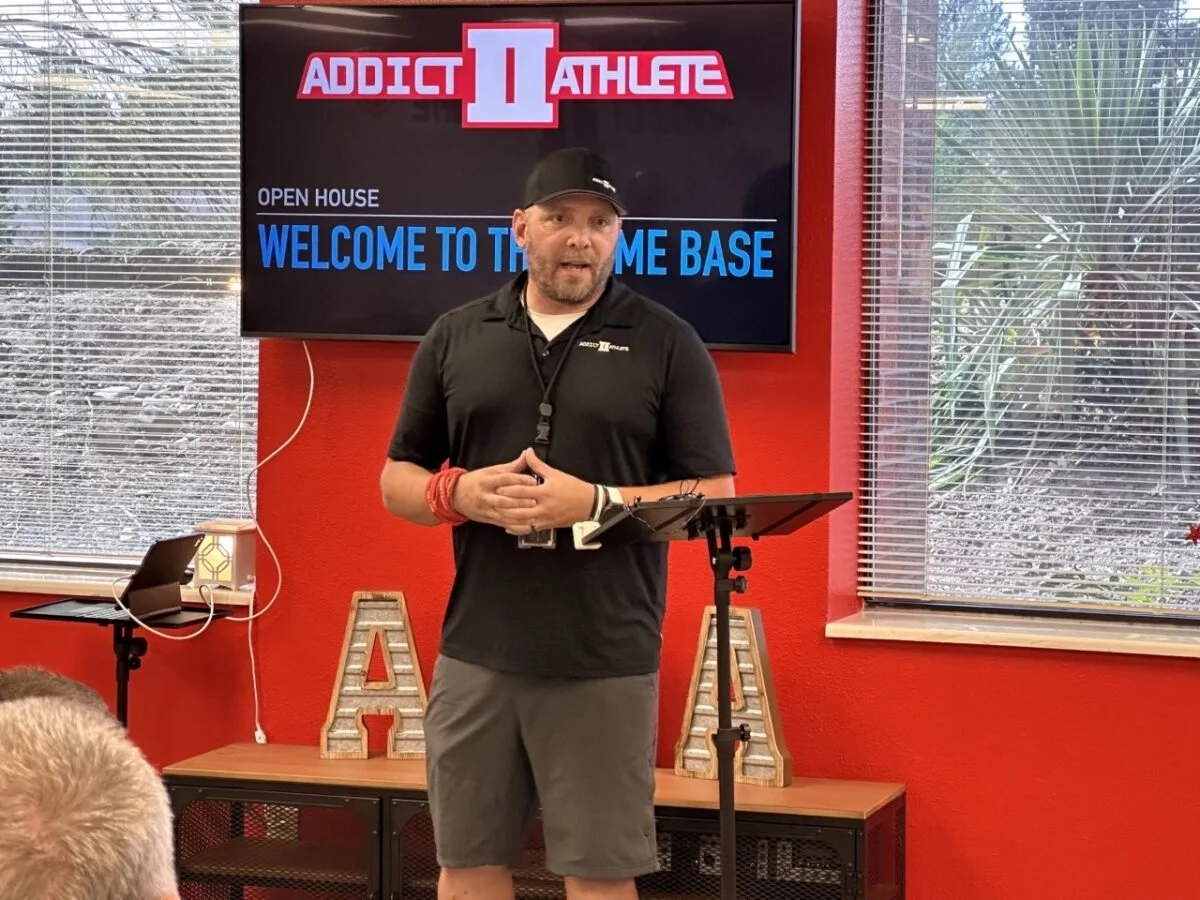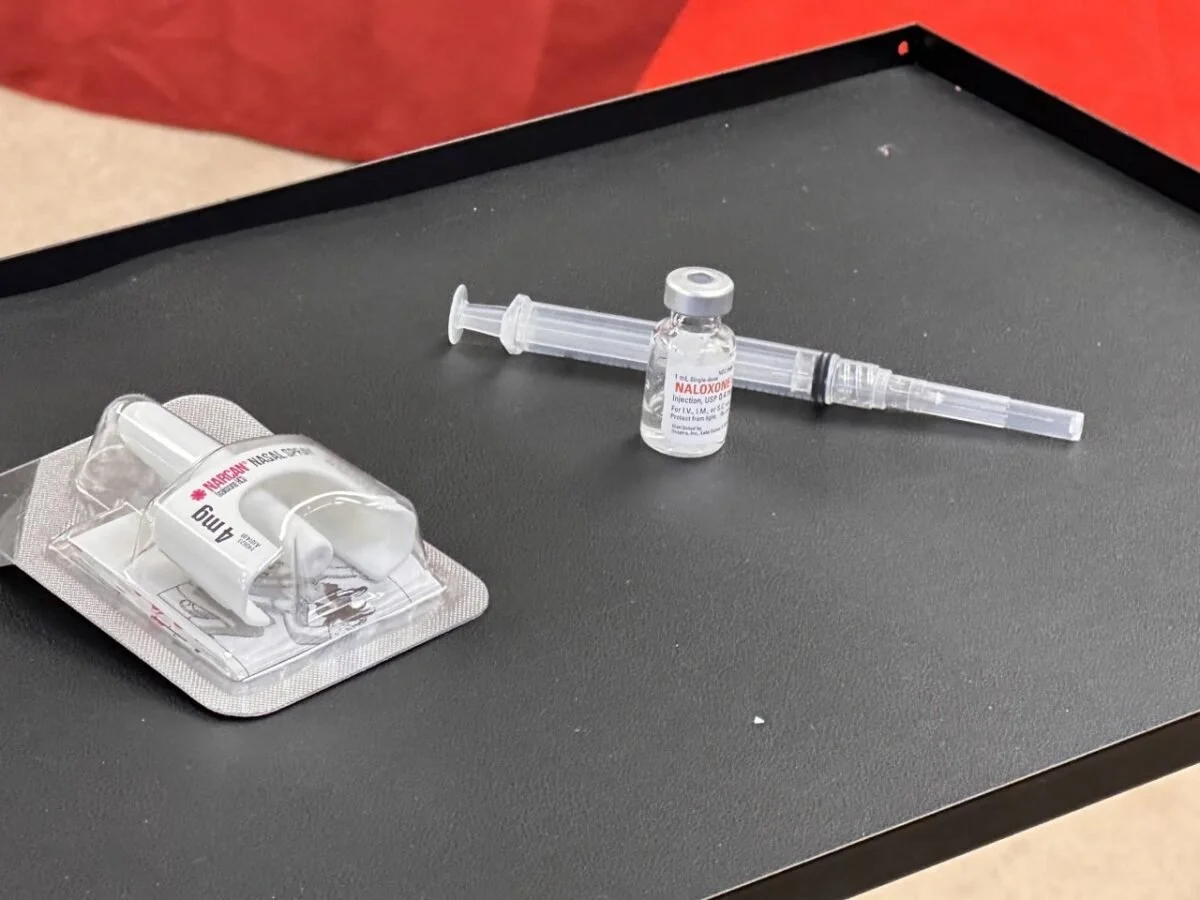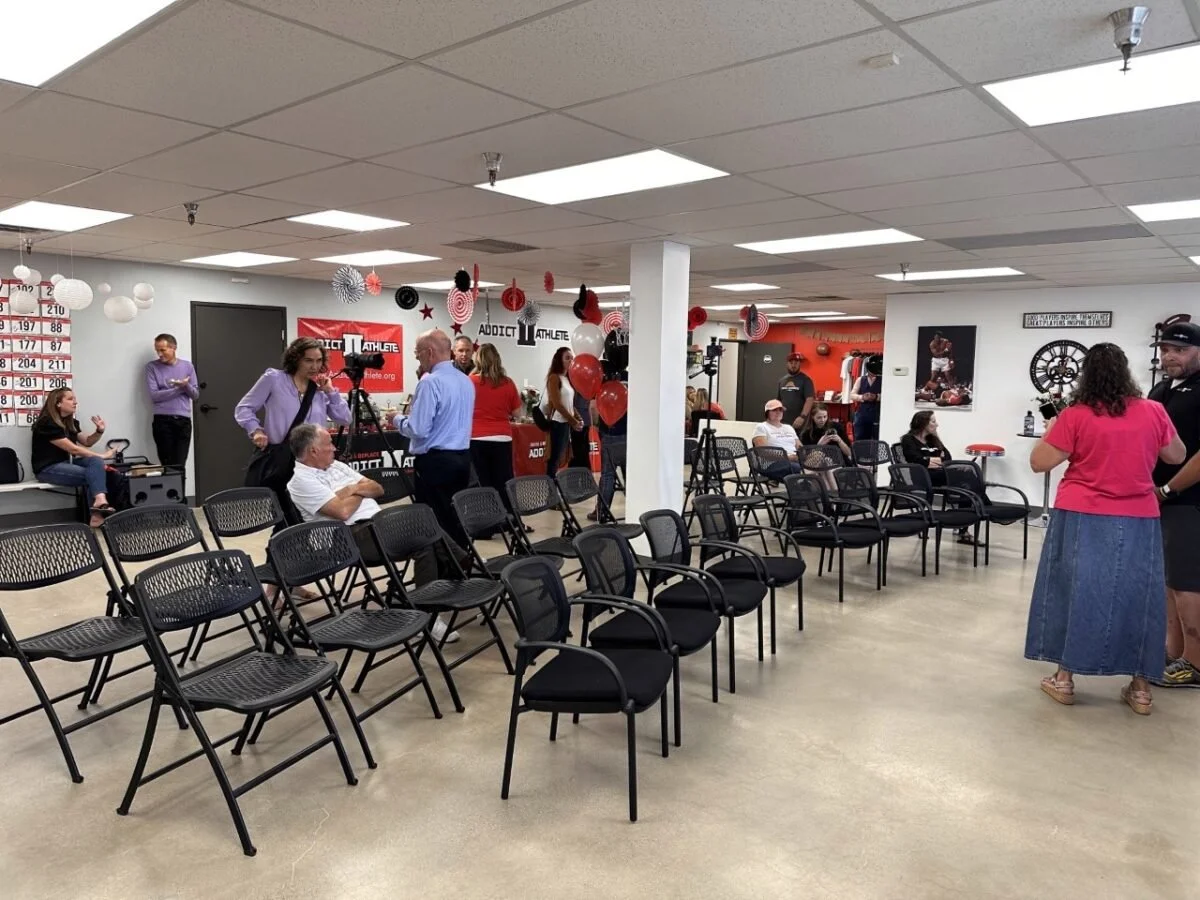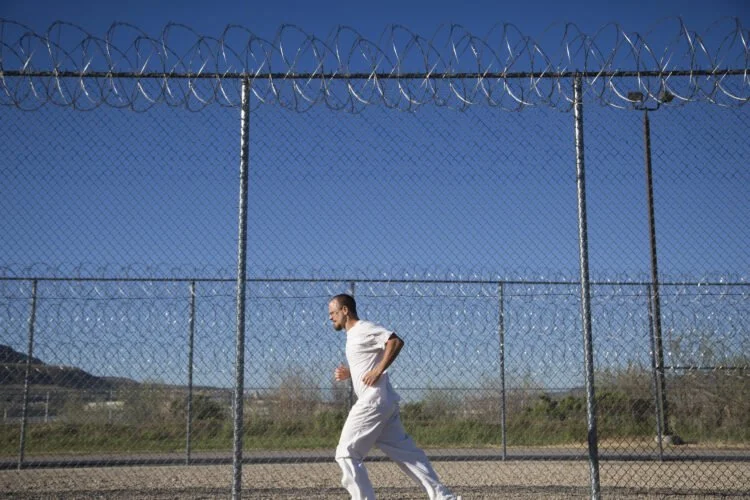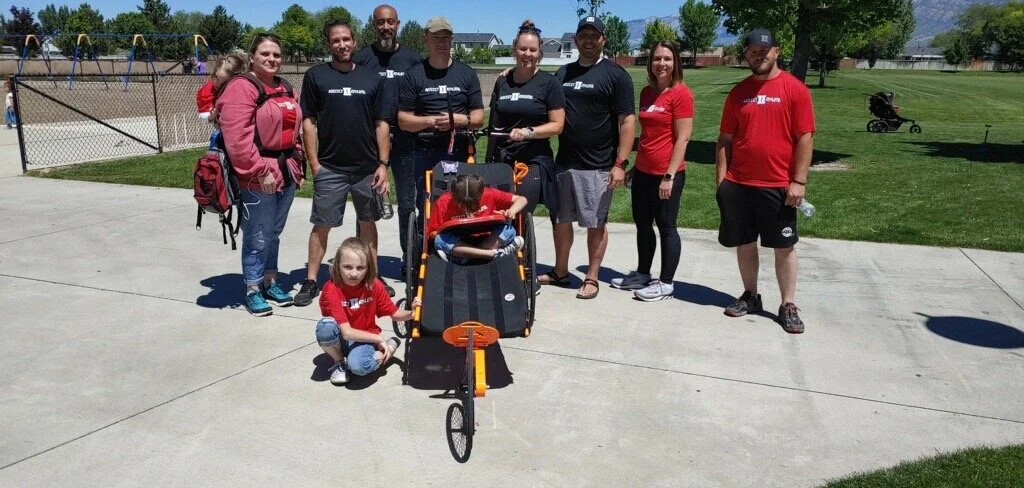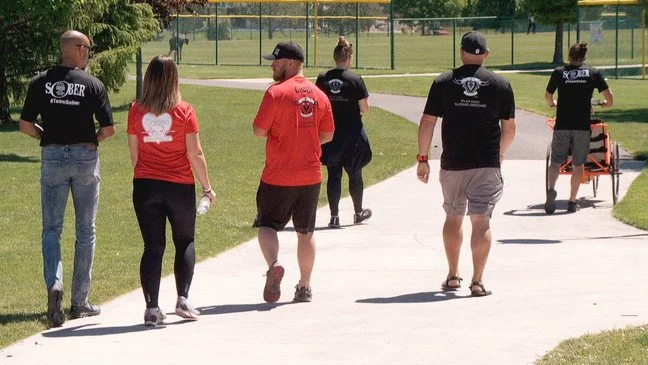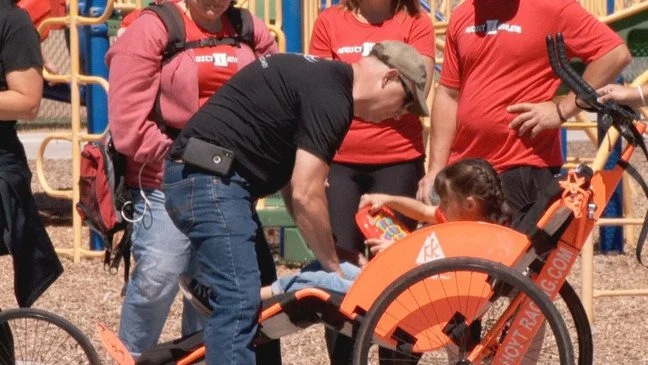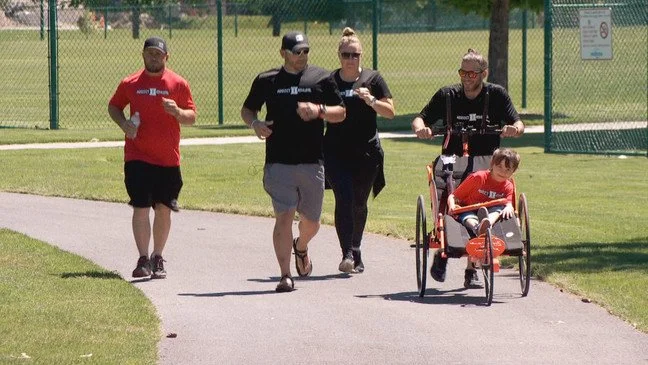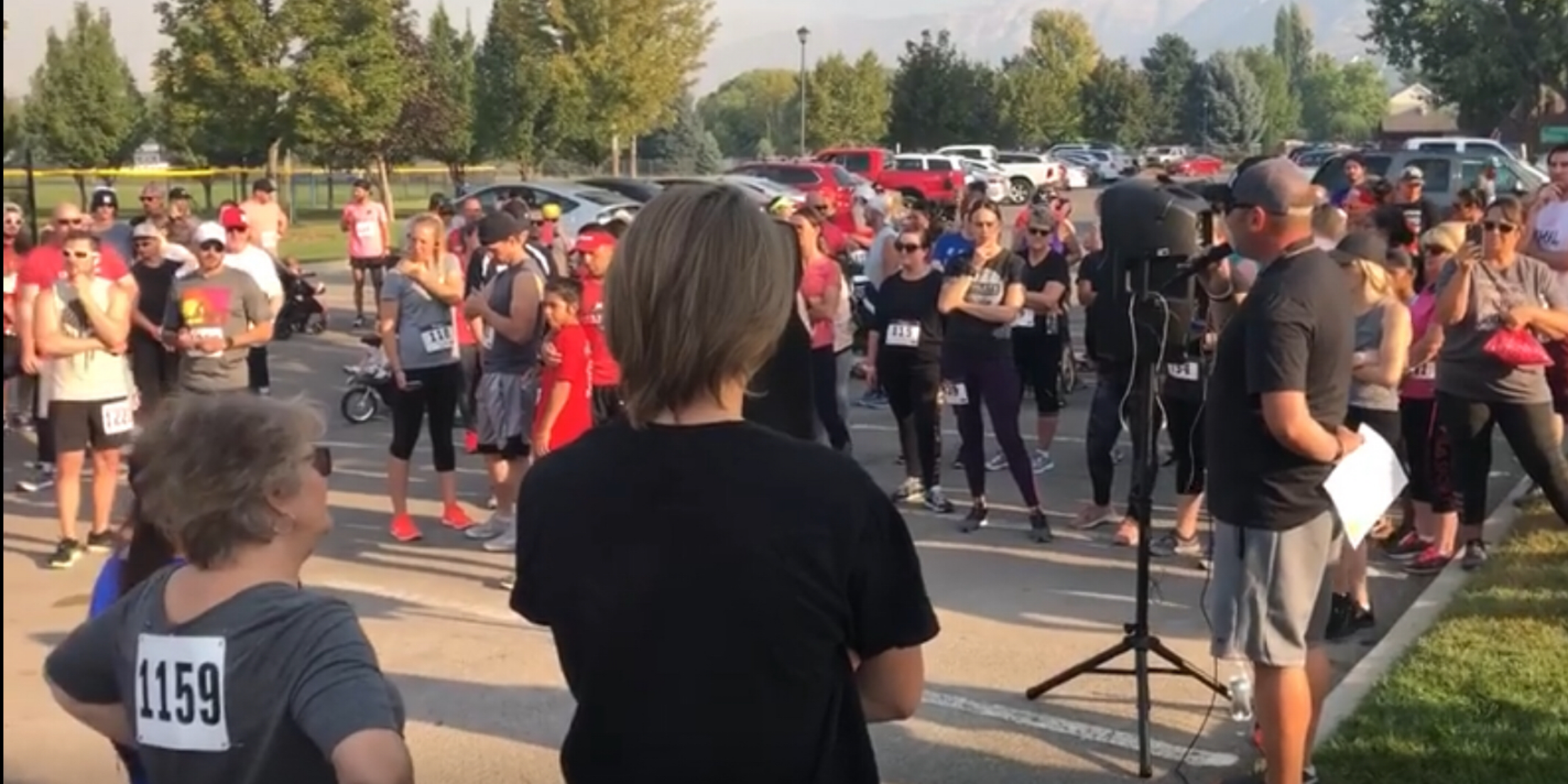
NEWS
Addict II Athlete: Washington City woman overcomes addiction, loss, jail and cancer to reclaim her life
Judy Berrocal smiles for the camera with her daughter and grandson location and date not specified.
Written by Jessi Bang Apr 18, 2025 St. George News Article
She lost two children, cycled through jail and survived breast cancer — now, 13 years sober, this Washington City woman is turning her pain into purpose.
“I kept going down that negative path, looking for validation in other people and chasing acceptance wherever I could find it,” Judy Berrocal told St. George News. “And using made that easy.”
Berrocal recalled her battle with addiction, which started at 10 years old when she began drinking and using marijuana. By 13, meth had entered her life. She then faced a series of traumatic experiences while growing up in Utah County, she said, including sexual abuse, that shaped the path she would one day fight to overcome.
She entered the legal system as a teen, landing in juvenile detention and then a group home, where she turned 18. At 19, she became pregnant and gave birth at 20. She married her child’s father, an emotionally and physically abusive relationship lasted 13 years, she said. Though she stayed sober during her first two pregnancies, she said she used again during her third.
Judy Berrocal's three children are pictured with her sister, location and date not specified.
“With our last child, our little boy, he was born in 2004, and in 2006, he passed away because I accidentally backed over him,” she said.
Berrocal said the incident happened while the family was camping at Mirror Lake. She said she hadn’t used drugs or alcohol yet that day, and no charges were filed. What followed over the next five years was a blur. The Utah Department of Child and Family Services removed her oldest daughter from her care, and she said any ambition she had to hold her life together slipped away.
“Of course, our lives had been turned upside down,” she said. “It was really, really hard to believe in anything, especially myself.”
Berrocal’s middle child was born with a disability caused by a chromosomal deletion. When the child was 3 years old, Berrocal and her husband placed her in a care facility. As Berrocal cycled in and out of jail, her mother took custody of her other daughter.
Even after she regained custody, Berrocal said she was still using drugs and alcohol. In 2009, after her husband slapped her, she said she made the decision to walk away, though she left her daughter behind and continued using drugs.
A collection of photos captures Judy Berrocal’s journey from her time in addiction through her transformation in recovery.
Two years later, after accumulating more criminal charges, she was accepted into a last chance probation drug court, a program that required individuals to be on probation with violations and prison recommendations. This was her last chance and her first time in treatment after 23 years of substance use.
She said she continued getting in trouble with old friends and being kicked out of group sessions. Her therapist, Blu Robinson, founder of Addict II Athlete, suggested she attend one of their meetings. She ended up volunteering to help create a parade float for two weeks, which introduced her to a positive group of friends who ultimately saved her life, she said, adding that she has been sober since Dec. 9, 2011.
“I wouldn’t be here today if it weren’t for Addict II Athlete,” she said. “It changed my life. I created bonds with friends and support with people who were like-minded and got what I was going through. I didn't have to hide parts of me.”
Addict II Athlete is a support group for anyone affected by addiction, including parents, siblings, children and loved ones. Meetings for individuals under 18 are called the "Minor League," and everyone is encouraged to participate in service projects and sports activities.
A group of individuals in addiction recovery pose for a photo while representing Addict II Athlete at a community race, St. George, Utah, date not specified.
After graduating from drug court, Berrocal said she felt there was more to her journey. She began studying to become a substance abuse counselor and interned at Steps Recovery in Payson, later working at a methadone clinic in Orem.
While assisting at an Addict II Athlete meeting in St. George, she learned that Lions Gate Recovery was hiring, a place owned by individuals with whom she had previously worked. She said she submitted her resume and started in October 2018. By May 2019, she had transitioned to their Toquerville location, where she now serves as clinical program manager in residential treatment.
But Berrocal's journey didn’t end there. In May 2022, a routine mammogram revealed she had breast cancer. Six days later, her middle child died. Despite these challenges, she continued to lead the annual Aaron Navarro Memorial Tournament, an event that brings together 70 teams of recovering addicts from across the nation.
“It was amazing,” she said. “Out of 200 people, the tournament started with them walking in white shirts with pink boxing gloves that said ‘Your fight is our fight.’ Recovery has brought me this kind of support. You think no one will show up for you, and then you have people pull together without you even knowing.”
Judy Berrocal enjoys the outdoors while wearing Addict II Athlete apparel, location and date not specified.
In September of that year, she underwent a double mastectomy. Three weeks later, she started 12 weeks of chemotherapy, followed by five weeks of radiation. Finally, after reaching the two-year mark, her oncologist informed her that she could now transition to six-month appointments.
Berrocal continues to coach for Addict II Athlete and said she is excited about the annual unity draft, which will be held Saturday, April 19, at The Canyons Softball Complex in St. George. Individuals in recovery register to play and are randomly placed on teams that compete against one another, though there are no winners. The focus is on coming together to have fun, play and build fellowship.
The games will kick off at 8 a.m. and run until noon, with a break for a speaker, pizza and raffles. Play will resume from 1-6 p.m. The public is welcome and encouraged to attend, watch the games and meet the players. This year, there are 10 teams, each with 13 to 14 players.
“That’s 130 to 140 people in recovery coming to literally fellowship and play ball and not worry about what the scoreboard says,” she said. “A big thing with Addict II Athlete is that your worth is not valued on the scoreboard; it’s how you play the game. And we get to hold our heads high and fellowship with all levels.”
A group of softball players in addiction recovery pose for a photo while representing Addict II Athlete, location and date not specified.
For those in active addiction, Berrocal said she understands how the disease can convince individuals to hold back and isolate.
She shared this advice: "Just show up. No matter what’s going on, show up wherever you know help is available, whether it’s a 12-step meeting, Addict II Athlete or a treatment center — you won’t be turned away. That first step is the beginning of a life-changing journey."
About Addict II Athlete
Addict II Athlete is a nonprofit organization that relies on donations and funding to sustain its programs. Contributions help cover costs like reserving courts for weekly meetings, providing new athletes in recovery with the equipment they need to participate and supporting other essential services.
Weekly meetings take place on Wednesdays at Vernon Worthen Park in summer and the St. George Branch Library in winter. Each 45-minute session uses sports metaphors to explore recovery and is followed by a game like pickleball. The organization also leads a monthly service project in partnership with St. George. To get involved, visit their website or follow them on Facebook.
Read original article from the St. George News
Running Towards Recovery
By Julia K. Nebeker (’24) in the Fall 2024 Issue Y Magazine
A couple is tackling addiction with therapy and recreation.
Through Addict II Athlete, therapists Blu and Marissa Robinson help people replace addictive behaviors with healthier ones, such as training for races. Photo by BSTN Photography.
Addiction often develops on the heels of tragedy. Such was the case for Judy after she accidentally backed her car over her son, killing him. To cope with her grief and guilt, she turned to substances and fell into addiction.
A turning point came when her therapists, Marissa Thurston Robinson (BS ’98) and Blu Robinson, encouraged her to sign up for a 5K. This wasn’t just any race. The organizers had lost their own son in a similar tragedy. Supported by other athletes and coaches in the program, Judy not only trained for and ran the race but was inspired to become a coach and substance use disorder counselor herself.
The Robinsons have made physical activity a pillar in their approach to breaking cycles of addiction. Through their nonprofit, Addict II Athlete, they are helping people overcome addiction in 11 chapters in Utah and Arizona.
Born and raised in Payson, Utah, Marissa learned to love service from her mother, a special-ed teacher who educated the community about people with disabilities. Marissa observed her mother regularly taking in those who needed her help—from foreign-exchange students to pregnant teens with nowhere else to go. Marissa spent her childhood doing anything that got her outside—swimming, soccer, rock climbing, boating. While at BYU she pursued a degree in recreational therapy.
While working at a residential treatment center for at-risk youth, Marissa met fellow employee Blu Robinson. They eventually married, but not before working through challenges from Blu’s past. He’d grown up in poverty, struggled with drug addiction, and never finished high school. He’d quit using substances before meeting Marissa, but they attended therapy together. “He continued to work on his childhood trauma,” Marissa says. “We continued to work on our relationship.” She helped Blu get his high school diploma—and that was just the start. He eventually earned a master’s degree and became a mental-health therapist.
Photo courtesy of Steve Riggs Photography
In his recovery Blu had mountain biked to “erase and replace” his substance-abuse behavior. Seeing the approach’s benefits, Blu asked some clients he worked with to try a couch-to-5K program. It was a huge success. “We continued to grow and develop this philosophy and created the name of Addict II Athlete,” Marissa says.
Addict II Athlete meetings include a brief discussion on a recovery topic followed by a workout or activity. Unlike other addiction-recovery approaches that are anonymous, Addict II Athlete is peer based. “Everything is open,” Marissa says. This encourages accountability and forges healthy relationships as participants improve their health and “turn their mess into messages of hope and healing,” as the Robinsons like to say.
As the Robinsons continue to help individuals recover and find a higher purpose in their lives, Marissa says she is inspired by their athletes. “Talk about people who have resilience and grit and strength beyond anything I’ve ever seen,” she says. “Some of the things they’ve been through are heartbreaking, and to see them come out on top is a testament to the human spirit.”
Article Source- Y Magazine
Daily Inspiration: Meet Blu Robinson
VoyageUtah interviews Coach Blu Robinson about Addict II Athlete’s history and vision for the future, helping those affected by addiction and mental health. Read more.
Article from UtahVoyage-October 4, 2023
Today, we’d like to introduce you to Blu Robinson.
Hi Blu, thanks for sharing your story with us. To start, maybe you can tell our readers some of your backstory.
I (Blu Robinson), was working as a therapist for the Utah County Division of Substance Abuse and noticed a crucial gap in the services available to the community. I was determined to provide an alternative approach, unlike any other recovery support program that was available at the time. In the world of addiction recovery, traditional methods often revolve around 12-step programs and therapeutic interventions. I would embark on a journey to create a recovery program that would replace destructive habits with health, recreation, community, family support, and teamwork. This marked the birth of Addict II Athlete, a transformative initiative that has redefined how we view addiction and recovery.
In 2011, my realization came one afternoon when clients were discovered forging attendance records for 12-step meetings. Curious about their motives and pointing out those meetings were offered to help them, I discovered that these traditional meetings did not resonate with them. They felt that attending these meetings was merely a consequence rather than something genuinely beneficial. Drawing from his journey of recovery, Blu understood the power of finding alternative resources. For him, mountain biking played a pivotal role in developing sobriety. Inspired by this, he decided to create a new approach that would change lives.
Addict II Athlete was founded with a unique vision: to no longer identify individuals in active recovery as addicts but rather as athletes. This shift in terminology aimed to emphasize that addiction is a part of who we are, not our defining characteristic. By embracing this new identity, participants in the program found renewed hope and purpose. They were no longer confined by the stigma associated with addiction but instead empowered to redefine their lives on their terms.
My approach involved building a community recovery program centered around health, recreation, and teamwork. Starting with just five clients, I introduced them to the Couch to 5K running program. As they trained and progressed, their confidence grew, culminating in proudly running a 5K community race wearing the team name, Addict II Athlete, on their jerseys. This public display marked a significant turning point, breaking the chains of anonymity and showcasing the possibility of recovery.
The impact of Addict II Athlete extended beyond physical fitness. Addict II Athlete provided a platform for participants to share their recovery stories with strangers. As they ran alongside one another, the athletes became willing ambassadors of recovery, inspiring others with their journeys. The simple act of wearing the team name on their jerseys sparked curiosity and opened the door for meaningful conversations about addiction and the potential for transformation. We expanded our ability to serve in the community by volunteering for local race aid stations, speaking engagements, assisting disabled children in participating in events by pushing them in special wheelchairs designed for running and raising money to purchase those racing wheelchairs. Project Elf, our sub for Santa program helps parents who have been struggling with addiction, provides Christmas for their children, and so much more. Service became more of a focus than even the athletics we participate in.
Since its humble beginnings, Addict II Athlete has flourished into a nationwide movement. Today, thousands of athletes participate in the recovery program, and multiple chapters have emerged throughout Utah. The success of Addict II Athlete is a testament to the power of a supportive community, the resilience of the human spirit, and the transformative potential of redefining one’s identity. As a 501 C3 nonprofit program we rely heavily on donations and grant money to assist us in providing therapeutic services alongside our recreational events. Everyone has someone who struggles with addiction, and we believe everyone loves a good comeback story. Addict II Athlete allows that comeback story to become a life worth living.
In 2011, Addict II Athlete created a groundbreaking approach to addiction recovery, shattered the traditional mold, and created a beacon of hope for individuals affected by addiction. By shifting the narrative from addicts to athletes, this program has empowered countless individuals to reclaim their lives and rewrite their comeback stories. Through health, recreation, community, family support, and teamwork, Addict II Athlete has become a testament to the resiliency of the human spirit and the limitless potential for recovery and transformation. Our motto is simple, return the mess to the message.
Can you talk to us about the challenges and lessons you’ve learned along the way? Looking back, would you say it’s been easy or smooth in retrospect?
The path to acceptance and understanding was not an easy one. There were many challenges Addict II Athlete faced as we considered ourselves pioneers in breaking the stigma surrounding addiction, and how we successfully built bridges between law enforcement and the addiction community.
As a therapist and head coach of Addict II Athlete, I understood I would need to embrace the struggles: Addict II Athlete understood that to bring about real change, we had to confront the public’s apprehension head-on. The prevailing perception of addiction was often clouded by misconceptions and stereotypes, creating barriers for those seeking help. By stepping out of the shadows and sharing their stories, the athletes of Addict II Athlete demonstrated the true face of addiction—one that defied preconceived notions and shattered stereotypes.
Addict II Athlete’s mission was not only to support individuals in their recovery but also to break down the stigmatizing barriers that hindered progress. By showcasing the resilience and determination of our athletes, our organization shattered the perception that addicts were incapable of change. Through our efforts, we helped our community realize that addiction does not define a person’s worth or potential. Slowly but surely, the public perception began to shift, and Addict II Athlete became a symbol of hope and inspiration.
Many of our athletes in the Addict II Athlete program had once been taken from the community during their addiction. Now, in their recovery, they are determined to give back. Our organization encouraged the athletes to serve their communities, mending the wounds caused by addiction. By engaging in volunteer work and outreach programs, we demonstrated the transformative power of recovery and showed that addicts could become valuable contributors to society.
One of the most significant challenges faced by Addict II Athlete was bridging the gap between law enforcement and the addiction community. Historically, these two groups often found themselves at odds, with a lack of understanding and trust on both sides. However, Addict II Athlete recognized the importance of collaboration and worked tirelessly to build relationships with law enforcement agencies. Through open communication, shared experiences, and mutual respect, we successfully broke down barriers and fostered a sense of understanding and cooperation.
Despite the initial apprehension and the uphill battle we faced, Addict II Athlete emerged triumphant. Our dedication and perseverance in breaking the chains of stigma and building bridges with law enforcement have paved the way for a more compassionate and inclusive approach to addiction and recovery. Our organization continues to grow, inspiring countless individuals to reclaim their lives and redefine their identities beyond addiction.
Addict II Athlete’s journey from the shadows of anonymity to becoming a beacon of hope is a testament to the power of collective action and the resilience of the human spirit. By challenging public perception, serving the communities, and fostering relationships with law enforcement, we have broken down barriers and shattered stereotypes.
Can you tell our readers more about what you do and what you think sets you apart from others?
I (Blu Robinson) am a Clinical Mental Health Counselor (CMHC) and Substance Use Disorder Counselor (SUDC) and as the founder of Addict to Athlete my favorite title is Coach. I had a very traumatic upbringing in a very dysfunctional home and suffered from substance abuse and other challenges due to the trauma I endured as a child. However, since 1996 I was able to become clean and sober, eventually finding mountain biking as a foundation of my recovery. As a result, I have been able to transform my struggles into a mission to help others.
As a licensed clinician, and the head coach of the Addict II Athlete team, I provide support, education, and group process with a clinical component to those in recovery and their families. Through my experience, I have learned that the human spirit is far stronger than what we realize and no one is too far gone. Alongside my wife Marissa Robinson who is a Recreational Therapist and Athletic Director, we have truly made it our mission to reduce the current national overdose statistics that sit at (2023) 109,940 predicted overdose deaths in the United States. That means every day we lose 301 people every day to addiction.
Where do you see things going in the next 5-10 years?
Addiction is a complex issue that affects millions of individuals worldwide, and seeking help is often a crucial step towards recovery. However, one significant barrier to accessing the necessary support is the high cost of residential addiction recovery programs. This financial burden prevents many individuals from receiving the treatment they desperately need. As a result, community-based initiatives like Addict II Athlete are emerging as crucial front-line defenses against addiction.
Residential addiction recovery programs offer comprehensive care and a structured environment conducive to healing. However, they often come with a hefty price tag, making them unaffordable for the majority of individuals seeking help. The expenses associated with residential programs, including accommodation, therapy sessions, and medical care, can be overwhelming. Sadly, this financial burden limits access to treatment, leaving countless individuals without the necessary support to overcome addiction.
In light of the financial constraints faced by those seeking treatment, community-based addiction recovery programs have emerged as a viable alternative. Organizations like Addict II Athlete are leading the way in providing affordable and accessible recovery support. These programs focus on the power of community, utilizing group activity, peer mentors, family support, and structured recreation to help individuals in their journey to sobriety. By shifting the focus from expensive residential facilities to community engagement, these programs ensure that more people can access the support they need.
The exorbitant costs associated with residential addiction recovery programs limit access to treatment for many individuals struggling with addiction. Community-based initiatives like Addict II Athlete are emerging as vital front-line defenses, offering affordable alternatives and emphasizing the importance of community support in establishing a robust sober support system. By combining the strengths of the medical model with community engagement, we can create comprehensive solutions that address the diverse needs of individuals on their journey to recovery. It is through these collective efforts that we can make addiction treatment more accessible, affordable, and effective for everyone in need.
Contact Info:
Addict To Athlete is Changing How Many Recover From Addiction
Sitting on a folding chair in a freshly painted room, Coach Blu holds a card in his hand. He looks around the room and calls out the name of an athlete from those gathered around him, holding his card up so he can read it.
“Tell me your favorite part about school.”
The athlete who was asked the question looks around at all of the friendly faces and tries to think of an answer. Finally, the athlete provides a one-word answer but is prodded by the coach to add more.
- Advertisement -
The Addict to Athlete (AIIA) meeting this particular Tuesday evening involves Ungame, a game meant to spark conversation and communication.
This is a typical AIIA meeting. Instead of being an anonymous group, AIIA is a group where past problems and addictions are shared openly so others can learn. “Turn your mess into a message” is a quote heard often when around the team.
AIIA was started in 2011 by Blu Robinson, a man who struggled with his own addictions. Sober since 1996, he has spent his life counseling others and building AIIA from the ground up – literally turning his mess into a message.
There are no fees, no commitments, and nothing required other than a desire to improve your life. “Erase and replace” is another quote often heard around the AIIA athletes.
The team does not care what addictions you may have struggled with, or if you even do.” Muggles” (those who do not suffer from addiction) are commonplace at the meetings and events. Almost everyone knows someone who has struggled, continues to struggle or has lost their struggle with addiction. The lessons and discussions are useful for everyone.
Not only does the team hold weekly meetings, but there are monthly races that Addict to Athlete tries to support around the communities. Service projects, such as Project Elf, provide Christmas for families in need. AIIA even has its own 5K and team half marathon race that both begin at the Sports Complex in Spanish Fork.
There are podcasts, One-on-one with Coach Blu on Facebook on Wednesdays, and open gym nights where the team exercises together.
Many athletes will even enter local races and challenges. In fact, in October, AIIA proudly sported neon pink shirts during a 24 hour trail challenge.
As an athlete and recovery coach myself, I can truly say that this team has saved my life. While I may not look like an athlete, I have completed a trail ultra marathon, multiple 5K races, and have learned how to take care of and love myself. These are things that I struggled with for a long time while I was deep in my addictions.
Please join us every Tuesday evening at 7:00 p.m. at 1875 S. State St. in Orem or any of the other 12 chapters across Utah, Colorado and Nevada to immediately become an athlete, a member of our team and start changing your life for the better.
Athletes, who am I?
I’m a champion!
Submitted by Earl Dyer
Read HERE
Addict II Athlete hosts open house for Orem facility; health department leads Naloxone training
On Thursday, Addict II Athlete celebrated the opening of its new facility in Orem. According to Blu Robinson, organization founder and mental health counselor, Addict II Athlete started out under the premise that those struggling with active addiction needed more free programs than just Alcoholics and Narcotics Anonymous.
“I was working as a therapist for the Utah County Division of Substance Abuse, and they didn’t have a lot of other meetings outside of the traditional twelve steps,” he said. “I knew that health recreation, specifically mountain biking, helped me in my addiction when I was younger.”
Addict II Athlete is a nonprofit that offering free community support groups, personal training programs, as well as online support and resources to both those who struggle with addiction and those with addicted loved ones. Addict II Athlete members also participate in races and events, as well as service projects.
The Homebase houses AIIA offices, a meeting space, and a gym for the organization’s athletes.
Robinson co-founded AIIA in 2011 with his wife, Marissa Robinson, a certified therapeutic recreation specialist. The organization now has nine chapters, including one in the Utah State Prison with the newest chapter on the Uintah and Ouray Reservation.
AIIA’s mission is to establish and maintain recovery by promoting lifestyle changes by erasing negative behaviors and replacing them with positive ones.
“If someone asked me why team Addict II Athlete works, it’s hard to put your finger on it,” Blu Robinson said. “Is it the physical stuff, is it the team support, is it the service that we render, it’s all of that, so it’s kind of hard to measure all of that stuff.”
Blu Robinson wants to shed light on the overwhelming number of lives taken each year by substance abuse, and to help people to see addicted individuals for who they truly are, people who are trying to cope with the trauma they have experienced.
“The public at large they see the negative side,” Blu Robinson said. “We lose more people to substance abuse than we do gun violence, than we do heart disease, all these things, but we don’t hear about it because what do we do about it? If people could see an addict that struggles for that core issue, that they’ve been hurt, we’d probably give them more grace.”
Robinson said that a common thread linking all of the individuals he’s worked with is that their addiction stems from some kind of inner turmoil.
“Most people look at the symptoms of addiction. They see the substance abuse and that’s not the real problem, that’s a symptom of a deeper problem,” he said. “At the core of everyone I have worked with in the last 20 years, I’ve noticed that it all comes from something that hurts… if we can look past the stigma of the substance use itself and get to the core reason of why that person is using, you’ll find out that that can be treated and healed.”
Blu Robinson believes in addressing the core issues that fuel addiction in order to help AIIA participants heal. “I don’t really like that word much, recovery because there has to be a point where you stop recovering and you begin to heal,” he said. “Instead of just focusing on that negative part, if we can move it, and learn from it, and let that stuff go, you can start to heal.”
The Addict II Athlete office is located at 1875 S State Street, Suite T500, in Orem.
As hard as Blu Robinson and the Addict II Athlete team works, substance abuse continues to be a nationwide problem. According to the Centers for Disease Control, 91,799 drug overdose deaths occurred in the United States in 2020.
That’s why, as part of the open house, the Utah County Health Department hosted a free Naloxone training.
Nicknamed the “Lazarus Drug,” Naloxone is an opioid overdose antidote that has been known to resuscitate individuals that are no longer breathing. Naloxone works by removing opioids from the pain receptors in the brain, and then binding to those same receptors, essentially restoring typical nervous system function.
Opioids are highly addictive narcotic substances that are commonly prescribed to treat pain, such as Oxycodone, Codeine, Tramadol, and Hydrocodone. According to opidemic.org, 80% of heroin users start with prescription opioids, and five Utahans die every week from an opioid overdose.
During the training, attendees learned how to prevent an opioid overdose in five steps. The first step is to recognize the signs of an opioid overdose, including:
Small, pinpoint pupils
Won’t wake up, has a limp body
Faint heartbeat
Shallow or stopped breathing
Blue or purple fingernails and lips
Gurgling or choking noises
From there, members of the public are taught to react (try and wake the person experiencing an overdose), administer Naloxone, proceed with rescue breathing if the overdosing individual has a pulse but is not breathing and, finally, stay with the overdosing individual until emergency services arrive.
Due to Utah’s Good Samaritan Law, bystanders can report an overdose without fear of criminal prosecution for illegal possession of drugs or controlled substances.
Utah has a Naloxone standing order, which allows pharmacists to distribute Naloxone to a third party without a prescription. Due to the Naloxone Law, individuals can administer Naloxone without fear of legal liability. The effects of Naloxone can last anywhere from 30 to 90 minutes, after which the individual is at risk of another overdose if the opioids are still in their system.
For more information on Naloxone and where to get it for free in Utah County, visit https://utahvalleydpc.org/what-is-naloxone/.
Skydive the Wasatch Hosts 3rd Annual Addict II Athlete Event
For the 3rd year in a row, Skydive the Wasatch and the Uintah Basin chapter of Addict II Athlete have joined forces for an all-day Addict II Athlete Skydiving Event. Addict II Athlete is a nonprofit organization that assists individuals touched by addiction and mental health. Addict II Athlete was formed as an alternative to […]
For the 3rd year in a row, Skydive the Wasatch and the Uintah Basin chapter of Addict II Athlete have joined forces for an all-day Addict II Athlete Skydiving Event.
Addict II Athlete is a nonprofit organization that assists individuals touched by addiction and mental health. Addict II Athlete was formed as an alternative to other recovery programs and is built on a model of “erase and replace.” Their mission is to establish and maintain recovery by promoting lifestyle changes through erasing negative behaviors and replacing them with positive ones. They implement this through support meetings, group workouts, marathons, and events like skydiving with Skydive the Wasatch.
James Johnson, the leader for the Uintah Basin Chapter of Addict II Athlete said that he noticed after a couple years, addicts tended to fall off of typical AA or NA 12-step fellowship groups. Addict II Athlete provides a new way for those individuals to recover while incorporating healthy lifestyle habits.
Founded in 2011 by Blu Robinson, Addict II Athlete is a nationwide action-oriented nonprofit group with multiple chapters in the U.S. as well as some in other countries. Addict II Athlete focuses on goal attainment for their participants, who are not only addicts, but also friends and family members and anyone affected by addiction and mental health.
Addict II Athlete Founder, Blu Robinson (left) and leader of Uintah Basin Chapter of Addict II Athlete, James Johnson (right) before jumping in 2021 Addict II Athlete Skydive the Wasatch Event.
Johnson, the leader and fitness coach of the Uintah Basin Chapter of Addict II Athlete faced his own addiction issues and was introduced to the Addict II Athlete program while in prison for armed robbery. When Johnson was released, he took on running as a way to cope with his addiction and mental health issues and would post videos online about how to deal with anxiety through running. Shortly after, he started the Uintah Basin Chapter of Addict II Athlete so that he could help others recover from addiction through athletics and a positive support network.
“When I started the chapter, I had the desire or thought to help people experience a new, healthy way of combating their past,” Johnson said. “I wanted to help people erase poor decisions and replace it with something of value.”
On May 14, Johnson is teaming up with Skydive the Wasatch for Addict II Athlete’s annual day of leisure, recreation, and skydiving. Johnson chose skydiving as an activity for his Addict II Athlete students because skydiving gives a similar endorphin release to drugs, but more importantly, because of the lessons his students can be taught through skydiving.
“Skydiving helps you overcome fear,” Johnson said. “It teaches you faith and commitment.”
Each year, Johnson has picked a different lesson for his students to learn during their Skydive the Wasatch event.
“Last year, it was overcoming fear. Year before, it was commitment. This is the 3rd year the event has been done,” Johnson said.
When asked why he chose Skydive the Wasatch as the place to host the event, Johnson said he initially chose Skydive the Wasatch because of its premier location to Mount Nebo, the tallest mountain on the Wasatch Front, but has continued to host the event there because of the support that owner, Leon Roullard, and his team have provided to his group.
“It is so enjoyable to see the lights come on for these folks as they realize just how great skydiving feels,” Roullard said. “The moment they realize that life without drugs can feel this good.”
The upcoming Addict II Athlete skydiving event will take place at Skydive the Wasatch on May 14, 2022. This full-day-long event is for recovering addicts and their friends and family to get together, watch loved ones jump, and support each other in their recovery.
There will be an Addict II Athlete meeting both before jumpers take off for their skydiving experience and while those who have chosen to jump are skydiving. Food and other activities will also be provided throughout the day.
The Addict II Athlete Skydive the Wasatch event is open to everyone. This year, Johnson has even joined forces with local law enforcement officers and military.
“The Chief of Police is coming, APP (Adult Probation and Parole) officers, military, highway patrol,” Johnson said.
“We’re trying to get them to stop playing cops and robbers. This event allows us to come together as one.”
The Addict II Athlete Skydive the Wasatch Event will start around 7:45am and will last until all jumpers are finished.
For more information about Addict II Athlete or their event with Skydive the Wasatch, reach out to James Johnson at (435) 724-7733 or Leon Roullard at info@skydivethewasatch.com.
Want to plan an event at Skydive the Wasatch? We’re the hottest spot to throw a party! Give your guests a memory they’ll never forget! Plan your birthday party, corporate event, bachelor/bachelorette, or anything you can think of, at Skydive the Wasatch! We specialize in working with large team building organizations! Want more info? Give us a call at (385) 321-0284 or send an email to info@skydivethewasatch.com.
Utah addiction recovery programs receive state grant funding
BRIANA SCROGGINS, Standard-Examiner file photo
Donald Duncan, of Carbon County, runs along the razor wire fence during the Addict II Athlete run at the Utah State Prison's Promontory facility in Draper on Tuesday, April 28, 2015. The 5K is targeted to providing a health and stress outlet.
In 2017, L.T. Weaver’s son was in an accident that left him clinging to life. The situation was so upsetting, Weaver started drinking alcohol to cope.
“He was critically injured and the doctors kept telling us to pull the plug,” Weaver said. “I decided to use this as an excuse to drink myself to death.”
Weaver’s son survived the accident with some complications, but Weaver was already headed down a dangerous path to addiction, so he checked himself into a hospital for help.
“That, plus the accident, was a perspective change in life,” he said. “We sold our house, downsized, got out of debt and I decided to focus on spending the last half of my life doing something good.”
Weaver, a photographer and videographer, decided to open Recovering Addict, a company based in Ogden aimed at helping people stay sober from both alcohol and drugs through treatment and exercise. He said during the pandemic, he decided to go live online seven days a week. The response exploded from across the world, he said.
“Exercise is a huge benefit to anybody, so we decided to partner with Iron House gym on 14th and Wall and five days a week, we spend one hour exercising followed by a relapse prevention program,” Weaver said. “Once a month, we have activities that range from painting to rock climbing, hiking and laser tag. It’s all about having sober fun and learning new hobbies and experiencing healthy rewards.”
Weaver’s nonprofit organization is one of seven across the state awarded a total of $4 million in grant funds through the Health, Exercise, and Addiction Recovery Program. The HEAR Program is the first of its kind in the state, said Shanel Long, substance abuse treatment administrator with the Utah Department of Human Services.
“Although grants have been awarded in the past to support recovery from substance use disorders, this opportunity is unique in focusing specifically on physical health and wellness with treatment,” Long said. “We selected organizations currently offering or hoping to include physical wellness services who could quickly engage and recruit those in recovery.”
That’s exactly what Weaver’s organization is all about.
“The grant money will help more than I can even imagine,” he said. “I wanted to offer instant support and this will help cater to those who need support immediately.”
The organizations competed for funding grants through a procurement process, said Brook Dorff, public information officer for the Utah Department of Human Services. A total of $1 million per year over four years will be distributed from the state’s general fund combined with the federal Substance Abuse and Mental Health Services Administration Block Grant. Dorff added that exercise incorporated into treatment plans have been researched extensively and proven successful in keeping addicts in recovery longer.
Other organizations receiving grant money include:
Addict II Athlete, a statewide in-person and virtual support group along with personal training.
Fit to Recover in Utah, Salt Lake and Summit counties, a brick-and-mortar gym offering classes in fitness, nutrition, education, community meal preparation and creative arts.
Papilion House, an organization in Utah and Salt Lake counties assisting people who have been incarcerated to integrate back into the community as well as offering free memberships to local gyms, meal planning, nutrition and medical management.
School of Addiction Recovery, or SOAR, in Ogden and Weber County. SOAR focuses on youth and adolescents ages 10-18 and hosts group classes, an open gym, substance abuse prevention and recovery, and physical fitness activities such as mountain biking, rock climbing and weight lifting.
Warrior Strength in Utah, Weber, Summit and Salt Lake counties. The organization focuses on the community aspect of substance use disorder recovery through online classes. Once a week, a family-focused fitness class integrates the member’s family and friends, other allies and additional social supports.
Flourish Adventures in Salt Lake County, a paid internship program teaching professional baking to those recovering from substance use disorders with a history of incarceration. Participants receive health and wellness coaching, stress management techniques, meal preparation and holistic health interventions.
Read Article HERE
Addict II Athlete Aims to Erase Labels Through Athletics, Service
The nonprofit Addict II Athlete uses athletics to help people working on addiction issues find a new purpose and identity. Their friends and loved ones can join the team, too.
(KUTV) — The nonprofit Addict II Athlete uses athletics to help people working on addiction issues find a new purpose and identity.
KUTV: Addicted Utah report
Their friends and loved ones can join the team, too.
"This problem is so widespread that everyone has at least one person in their family that struggles," said Blu Robinson, founder and head coach.
Robinson was working as a therapist when he started Addict II Athlete in 2011. His patients found it as a good alternative to just sitting in recovery meetings.
'Addict II Athlete' aims to erase labels through athletics, service (Photo: KUTV)
"They feel more comfortable when they're moving rather than just sitting still," Robinson said.
Getting outside helped Robinson with his own addiction.
"It gave me more of a purpose," he said. "I didn't identify as an addict anymore."
He aims to help other athletes find their new identify with a philosophy he calls "erase and replace":
'Addict II Athlete' aims to erase labels through athletics, service (Photo: KUTV)
"Erase the addiction, but replace it with something of greater value, which is health, exercise, service."
In addition to various athletic events and activities, Addict II Athlete also hosts podcasts, free online groups, offers individual counseling, and more.
"It's been a huge part of my recovery and my life," said Brett Frew.
Frew joined the team about two years ago after he knew he needed to change. He has always been an active person, and being with people who have the same mindset keeps him accountable.
"If I'm struggling or having a hard time, I have an entire team I can reach out to and they're willing to help," Frew said.
‘Addict II Athlete' aims to erase labels through athletics, service (Photo: KUTV)
Athletics is just a part of the nonprofit. They also focus on helping the community.
"Part of who I am, and the core of me, is giving back to others," said Jim Copeland, a certified sober coach with the group.
Copeland was attracted to the program because he is a runner. But the service aspect has inspired other dreams.
"My goal is to start my own chapter and help others," he said.
'Addict II Athlete' aims to erase labels through athletics, service (Photo: KUTV)
He says it's important for the community to see people who struggle with addiction contribute to society.
"The things that we've done in the past don't define who we are today," Copeland said.
And that's the message Coach Robinson hopes all his athletes will learn.
"There's always an extra mile we can go, there's always a little bit more fuel in the tank, there's always a little bit further we can push ourselves."
This weekend, May 29 and 30, Addict II Athlete is holding its "Break the Cycle" relay race to raise funds for its athletes to continue their recovery work. They run one mile for every life lost to drug overdose. Robinson says this year, they are running 185 miles. They will run around Utah County.
There are about nine chapters of Addict II Athlete statewide, and the group is expanding to other parts of the country.







